SCANDINAVIAN-CANADIAN STUDIES/ÉTUDES SCANDINAVES AU
CANADA
Vol. 19 (2010) pp.230-260.
Title: Readymades, Rejects and the Ready-to-Hand: Found Objects in the Films of Aki Kaurismäki
Author: Lawrence D. Smith
Statement of responsibility:
Marked up by
Martin Holmes
Marked up by
Martin Holmes
Statement of responsibility:
Editor/Rédacteur
John Tucker University of Victoria
Editor/Rédacteur
John Tucker University of Victoria
Statement of responsibility:
Book Review Editor/Rédactrice des comptes rendus
Helga Thorson University of Victoria
Book Review Editor/Rédactrice des comptes rendus
Helga Thorson University of Victoria
Marked up to be included in the Scandinavian-Canadian Studies Journal
Source(s): Smith, Lawrence D. 2010.
Readymades, Rejects and the Ready-to-Hand: Found Objects in the Films of Aki Kaurismäki.Scandinavian-Canadian Studies Journal / Études scandinaves au Canada 19: 230-260.
Text classification:
Keywords:
article
article
Keywords:
- cinema and found objects
- cinema and philosophy
- cinema of social engagement
- Finnish cinema
- Heidegger, Martin
- Kaurismäki, Aki
- MDH: started markup 11th March 2010
- MDH: entered author's proofing corrections 1st September 2010
- MDH: entered editor's proofing corrections 9th September 2010
- MDH: entered editor's proofing corrections 10th October 2010
- MDH: entered editor's proofing corrections 15th November 2010
- MDH: added page numbers from print journal edition 11th April 2012
Readymades, Rejects and the Ready-to-Hand: Found Objects in the Films of Aki Kaurismäki
Lawrence D. Smith
ABSTRACT: This article considers the role of found objects in the work of Finnish
film maker Aki Kaurismäki. Acknowledging the legacy of such objects in 20th-century
art and performance inaugurated by the “readymades” of Marcel Duchamp and Dadaism,
this article focuses on the concept of Zuhandenheit (ready-to-hand), the meaningful employment of objects in relation to living in the
world. Kaurismäki’s use of found objects, both within the diegesis of various films
and in the making of the films themselves, is compared to the existential phenomenology
of Martin Heidegger, specifically in relation to that philosopher’s concerns with
how human beings “dwell” in post-World War II Europe. Kaurismäki has many connections
with mid-century existentialism,
and his creative employment of found objects in constructing his films creates a distinct
cinematic realm frequently called “Aki-” or “Kaurismäki-land.” Found objects prove
to be indispensable in creating the distinctive style of the
films, serve as plot elements, furnish the mise-en-scène, provide material links between the various films, and, as in Zuhandenheit, are utilized to address Kaurismäki’s fundamental concerns with dwelling in the real
world, as well as in Aki-land.
RÉSUMÉ: Cet article aborde le rôle des objets trouvés dans l’oeuvre du cinéaste finlandais
Aki Kaurismäki. L’utilisation que fait Aki Kaurismäki des objets trouvés est comparé
aux objets « tout faits » de Marcel Duchamp et aux performances dadaïstes, ainsi qu’à
la phénoménologie existentielle
de Martin Heidegger, plus précisément à son idée de «l’habitation» et à son concept
de la Zuhandenheit (être à-portée-de-la-main), l’usage significatif
d’objets reliés à la vie dans le monde. Les objets trouvés s’avèrent indispensables
à la création du style cinématographique distinct des films de Kaurismäki, fournissant
des liens matériels entre eux, et, comme pour la Zuhandenheit, servent à nous renvoyer au souci fondamental de Kaurismäki pour le concept de l’habitation,
que ce soit dans le vrai monde ou dans celui qu’il a créé.
At the point of crisis in Aki Kaurismäki’s film Mies vailla menneisyyttä [The Man Without a Past] (2002), the two main characters, M and Irma, sit at a table in the “kitchen” of
the shipping container that M lives in. There is a single, ceramic cup on an
otherwise empty table between the two (Figure 1). M is leaving and Irma is remaining:
they have fallen in love, but any possible future together has been called into question.
The cup is absolutely typical, a nondescript, mass-produced object, a “readymade.”
Yet, it is placed at the centre of the pictorial composition. While oriented toward
M, it is never clear which character has been using the cup. It is never lifted or
drunk from; rather, it constitutes a focal point for both characters throughout the
scene and is even emphasized at the end of the scene when both M and Irma lower their
gaze toward the cup in tacit acknowledgement of parting and potential loss. The unused
cup is surrounded by the restrained, but poetic discourse of Irma and M. It is present
as a “readymade” in a convergence of diegesis, compositional juxtaposition and metaphor:
is it a cup
that cannot be drunk from, or one that has been emptied?
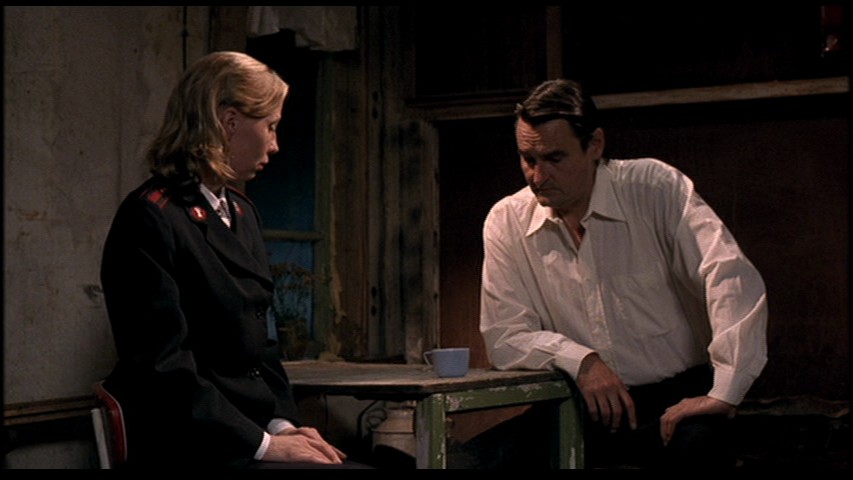
Figure 1
Aki Kaurismäki is Finland’s foremost director, an internationally recognized auteur who enjoys greater success with audiences abroad than at home. While typically labeled a Finnish director, and thus a national artist, Kaurismäki
openly acknowledges the influence of films and directors from diverse nations and
eras. He has cited Luis Buñuel, Yasujiro Ozu and Robert Bresson, in that order, as
his foremost influences (Fisher 254); in interviews, he has frequently discussed
Vittorio De Sica, Jacques Becker and
Frank Capra, as well as numerous other directors whose films have a specific correlation
to one of his own. With a distinctive preference for post-industrial cityscapes,
eclectic soundtracks and characters whose verbal and emotional reticence is captured
in the protracted stillness of a fixed-plan camera, Kaurismäki has managed to create
not only a personal style through his films, but a separate, cinematic universe.
This article considers the role in that cinematic universe of found objects, these
typically being mass-manufactured material goods that have been either discarded or
neglected, and that are subsequently discovered by a Kaurismäki protagonist. Because
these items have already been manufactured, typically being consumer durable goods
from now obsolete industries, such objects are pre-existent to the character and plot.
Hence, they exist as given elements within the world of the protagonist, who subsequently
discovers in these found objects both utility and new meaning.
I argue that this process of discovering found objects, particularly as presented
in Mies vailla menneisyyttä, is a regular feature in much of Kaurismäki’s work, and an important element to consider
in understanding his filmmaking methods in general. This paper seeks to highlight
the primary role that found objects play in the films, the material and thematic links
that such objects provide between films, and how the continual inclusion of such objects
sustains the overarching framework that derives from and contains each individual
film. This essay hopes to encourage more extensive analyses of the existential metaphysics
of “Kaurismäki-land” or “Aki-land,” as the collective realm of the films is sometimes
called, and the relationship of
that cinematic realm to the conditions of modern existence.
A good deal of criticism on Kaurismäki wrestles with the temporal disharmonies and
contradictions in Kaurismäki’s fictional universe. Stylistically and materially, many of the films evoke associations with mid-twentieth
century popular culture in Finland specifically and the West in general, while at
the same time asserting links to the themes and styles of internationalized auteur cinematic culture of the 1950s and 60s. Kaurismäki’s films seem to belong to an
earlier era while at the same time patently belonging to the here and now: found objects
are fundamental in generating and sustaining these temporal contradictions, and thus
are a part of what constitutes the experience of time within Kaurismäki-land. In
fact, an uncanny awareness of time un-supplemented by memory, yet still with a sense
of significance, is the idealized condition of the protagonist in Mies vailla menneisyyttä.
In considering Mies vailla menneisyyttä, it is important to recognize that film’s position within the so-called “Finland”
trilogy, with Kauas pilvet karkaavat [Drifting Clouds] (1996) and Laitakaupungin valot [Lights in the Dusk] (2006) to either side. It is also necessary to consider the Finland trilogy in
relation
to the earlier “loser” trilogy, comprised of Varjoja paratiisissa [Shadows in Paradise] (1986), Ariel (1988) and Tulitikkutehtaan tyttö [The Match Factory Girl] (1990). Essentially, Mies vailla menneisyyttä is the fifth piece in a cinematic sextet which, taken in its entirety, provides numerous
examples of the creative employment of found objects by characters and filmmaker alike.
Therefore, I look to these other films to trace the function and meaning of found
objects throughout the sextet, and how these objects relate to matters of memory,
aura and authenticity.
Found objects: mass production, juxtaposition and aura
What is a found object? From Marcel Duchamp’s objets trouvés or “readymades” in 1914, when objects such as a urinal, a bicycle wheel and a bottle
rack were re-contextualized
and exhibited, found objects and found materials have played an important role in
modern art and performance, as evidenced in Dada, surrealism, “trash” art, collage,
and pastiche. Various artists have offered ironic responses to industrial
society by employing found objects (or materials extracted from mass-produced goods)
to create works that critique modern society. Yet, ironically, these same objects
may also become fetishes of cult enthusiasm. Duchamp’s “Fountain” (1917), known to
most of us through photographic reproduction, is one example of
this phenomenon.
Why should a manufactured “readymade” acquire status as an art object? And why would
a photograph of a readymade also
seem to achieve such status? Is it all a matter of context and attribution? A mass-manufactured
object, or a mechanical reproduction, is nevertheless a thing itself. So, how might the copy of some original object manage in turn to acquire
its own thing-ness? To go further, how might a “readymade” or found object manage to achieve aura?
The German philosopher Martin Heidegger, who laid the foundation of existential phenomenology
with Sein und Zeit [Being and Time] (1927) and his subsequent writings, dealt extensively with the individual’s experience
of existence (Dasein), its inseparability from the world, and its relationship to objects in the world. In discussing the housing shortages of post-World War II Germany in a later essay,
Heidegger made the following observation:
Unser Denken ist freilich von altersher gewohnt, das Wesen des Dinges zu dürftig anzusetzen. Dies hatte im Verlauf des abendländischen Denkens zur Folge, daß man das Ding als ein unbekanntes X vorstellt, das mit wahrnehmbaren Eigenschaften behaftet ist. Von da aus gesehen, erscheint uns freilich alles, was schon zum versammelnden Wesen dieses Dinges gehört, als nachträglich hineingedeutete Zutat. Indessen wäre die Brücke niemals eine bloße Brücke, wäre sie nicht ein Ding. (2000 155-56, original emphasis)
This statement offers an implicit answer to the question of aura in asserting a “gathering essence” [versammelndes Wesen] to man-made objects, specifically those that are related to the activity of building, and thus ultimately to a concern with “dwelling” [Wohnen]. We may miss something if we think that it is only the framing of an object that gives that object a meaning; per Heidegger, the inherent meaning of the object is simply moved toward disclosure by its frame. Re-framing a found object, then, would point to the essence (one could also say “aura”) of a thing, whether that re-framing is a pedestal, a Dadaist performance, a photograph, or a film by Kaurismäki.[Our thinking has of course long been accustomed to understate the essence of the thing. The consequence, in the course of Western thought, has been that the thing is represented as an unknown x to which perceptible properties are attached. From this point of view, everything that already belongs to the gathering essence of this thing does, of course, appear as something that is afterward read into it. Yet the bridge would never be a mere bridge if it were not a thing.] (1993 355)
A found object, then, or “readymade,” has a double function: it is what it is, on
the one hand, but it also has a separate
value by virtue of its presence (or “gathering essence”), a presence that frequently
seems uncanny or strange to us, even surreal. Disclosed
within a new context (a urinal on a pedestal as opposed to one mounted on a washroom
wall, for example), the found object calls attention to itself and its surroundings.
It functions as art while at the same time pointing out that it is one’s awareness
of an object, as much as the object itself, that determines what “art” is, at least
in terms of subjective experience; yet, it also exhibits “gathering essence.” Thus,
the found object generates a kind of performance: it establishes a certain
site of existence and draws attention to human behaviour and presence, to Being, in
other words, within the field of that site.
In the films of Kaurismäki, the found object is almost always a complete thing rather
than a part or fragment of something, and it is typically a manufactured “readymade”
that has been discarded or left to neglect by an absent, therefore illegitimate,
owner. Once found, the object is put to immediate use, sometimes in a manner similar
to its original function or, sometimes, in a new context that discloses a hidden potential
within the object. A distinguishing feature of this implementation of found objects
is the aesthetic value that is derived simultaneously with its utilitarian value.
In other words, the object is always put to use, but that use is always aesthetic
as well as practical; Kaurismäki never places, say, a jukebox on a pedestal. Rather,
the jukebox is put to use, albeit in an apartment or a shipping container rather than
in a bar. If there is a pedestal, it is the frame of the film itself rather than
a literal frame created by a character within the diegesis. Thus, a jukebox included
in private living quarters rather than in a bar functions aesthetically as a found
object, as an element of the mise-en-scène, and as a diegetic source of music, as is the case in both Mies vailla menneisyyttä and the earlier Tulitikkutehtaan tyttö. In Kaurismäki’s cinematic universe, found objects always function.
In their functional aspect, found objects become tools for the protagonist, or as
Heidegger describes it, “equipment” [das Zeug] which he defines as “those entities
which we encounter in concern” [das im Besorgen begegnende Seiende] (1962 96; 1960
68). This concern, ultimately, is with dwelling and, thus, Being:
Die Seinsart von Zeug, in der es sich von ihm selbst her offenbart, nennen wir die Zuhandenheit. Nur weil Zeug dieses “An-sich-sein” hat und nicht lediglich noch vorkommt, ist es handlich im weitesten Sinne und verfügbar. (1960 69)
Zuhandenheit is related to seeing and understanding. When we work with a thing that is ready-to-hand, we move away from theorizing and engage in an activity that “has its own kind of sight” [hat seine eigene Sichtart] that sight being “circumspection” [die Umsicht] (ibid.). Circumspection, for Heidegger, may open one to awareness and authentic action. Zuhandenheit is the way in which we set about building our place in the world through equipment.[The kind of Being which equipment possesses—in which it manifests itself in its own right—we call “readiness-to-hand” [Zuhandenheit]. Only because equipment has this “Being-in-itself” and does not merely occur, is it manipulable in the broadest sense and at our disposal.] (1962 98)
In Kaurismäki’s cinema, such equipment is typically constituted by found objects,
which include bottles, canisters, clothing, shipping containers, record albums, portable
radios, vintage stereos, jukeboxes, used cars, stray dogs, and the fourth movement
of Tchaikovsky’s “Pathétique” Symphony. If we look upon the films themselves as products
of a manufacturing process,
a creative industry conducted by Kaurismäki over a period of some twenty-five years,
then it is appropriate to extend the category of found object to include both characters
and recurring personae throughout the films, an effect created by using the same actors
in certain kinds of roles from film to film. Found objects also play a certain role
in excess of a film’s particular diegesis, constituting a meta-cinematic category
of readymades: television footage, radio coverage, dialogue or actions described from
other films, as well as the use of pre-recorded music derived from old albums. Found
objects figure in the director’s creative process and even crop up as a means of production,
as in the case of Kaurismäki coming into possession of Ingmar Bergman’s old camera,
discussed below. In each of Kaurismäki’s films, there is a value attaching to found
objects that is emblematic of the value the filmmaker accords to idiosyncrasy, hetero-normative
love, and music, all of which are depicted as sources of inspiration in lives otherwise
surrounded by an unbearable emptiness.
Mies vailla menneisyyttä, authentic existence and dwelling
Mies vailla menneisyyttä explicitly represents an underlying creative process to many of Kaurismäki’s films:
forgetting (amnesia) as an opportunity to re-assemble an authentic identity in a world
of found objects. The film centres on the experiences of a welder, M, who upon arriving
in Helsinki by train in the middle of the night, goes to a park, falls asleep on a
bench and is assaulted, without being awakened, by a trio of thugs. They knock him
unconscious (or further into unconsciousness), rifle through his suitcase, steal his
money, discard his identification papers, and then, as classical music plays on a
portable radio taken from M’s suitcase, one thug dons M’s welding mask and watches
while the other two assailants continue to beat him. He is then left for dead. Shortly
after this, M staggers into a public bathroom, collapses a second time, and is discovered
by a washroom attendant who reports him as dead. M is subsequently taken to a hospital and officially pronounced dead. A few moments
later, he abruptly rises up, face and head swathed in white bandages, looks at himself
in a mirror, twists his broken nose straight and then grabs his clothes and departs.
We next see him lying asleep, or perhaps again unconscious from his concussion, on
the rocky bank of the harbour, head oriented toward the water. For the first time
in the film we see the day sky, open water and natural light. An old man has removed
M’s welder’s boots, exchanging them for his own canvas, rubber-soled deck shoes.
Two boys carrying a large plastic container between them on a pole also walk by; they
stop to look at the unconscious man and wonder if he is dead. M moves slightly, and the boys decide to help him.
What ensues is a story of amnesia, but with an emphasis on the creation of a new existence
rather than a quest to discover the old one. Within this beginning sequence, several
subjects are raised: the repeated question of whether M is dead or not; the nature
of human violence; night and day counterpoised as representations of self and amnesia;
and the discovery and employment of found objects: the plastic container with pole,
the stolen shoes and, in the view of both criminal and audience, M himself (Figures
2 and 3).
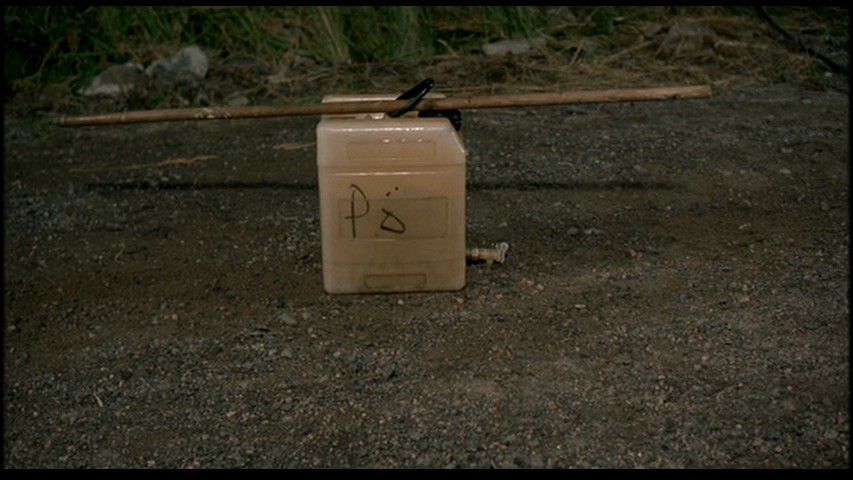
Figure 2
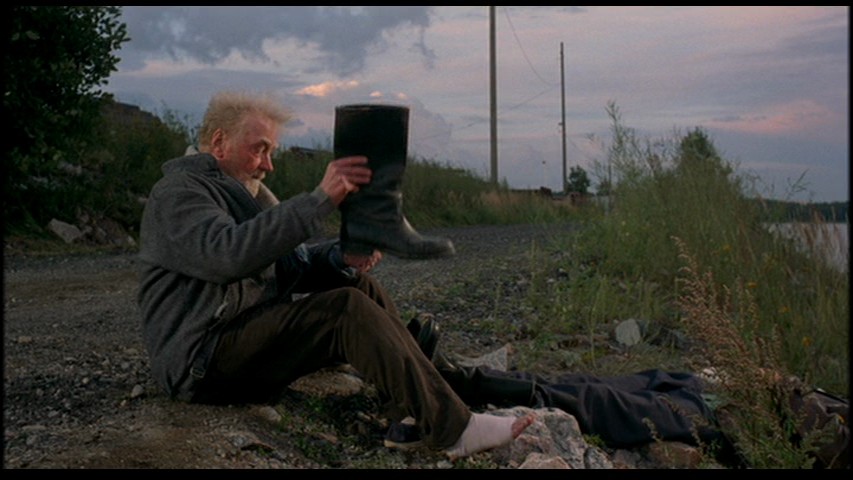
Figure 3
Talk of “authenticity” may seem archaic, quaint, or perhaps even dissonant in discussing
a post-modern filmmaker
such as Kaurismäki, but again this usage hearkens in an appropriate way to the existential
phenomenology of Martin Heidegger. For Heidegger, authentic identity can be at least
sparked by a recognition of the reality of death and a resistance to the loss of individuality
in das Man-selbst, the “they-self” that is established for each of us through conformity to social
norms (1960 266; 1962 311). Furthermore, in “Building Dwelling Thinking,” an essay
published in 1951, Heidegger talks about human dwelling as comprising the
ultimate object of building, while allowing that not all buildings are dwellings.
In Mies vailla menneisyyttä, one finds people living in improvised or transitory domiciles of various kinds (discarded
shipping containers, a dumpster, a night watchman’s office, the institutional interior
of a women’s dormitory, etc). Such sites are not so much buildings as they are containers
or compartments. However, it is not the domicile itself that guarantees authentic
dwelling, as Heidegger emphasizes: “die Wohnungen können heute sogar gut gegliedert,
leicht zu bewirtschaften, wünschenswert
billig, offen gegen Luft, Licht und Sonne sein, aber: bergen die Wohnungen schon die
Gewähr in sich, daß ein Wohnen geschiet?” [today’s houses may even be well planned, easy to keep, attractively cheap,
open to
air, light, and sun, but—do the houses in themselves hold any guarantee that dwelling occurs in them?] (2000 147;1993 348).
This point is demonstrated late in the film, in M’s return to his former home and
ex-wife, neither of which he fully recalls. The home is attractive and well-kept,
but we learn that the couple had lived in estrangement. Certain facts emerge, such
as the couple’s history of arguments and unhappiness, as well as M’s gambling addiction
and his loss of an extensive LP collection. But, the exchange of information is largely
factual, if humanely so. M, in fact, never recovers his memory. Rather, he discovers
the essential facts of his past without recalling them. Such discoveries merely clear
the way for his movement toward authentic being, which he has begun to establish through
living with purposeful engagement in the container village.
Through M’s actions, particularly in his sharing of vintage music recordings (found
objects that are also mechanical reproductions) which leads to the creation of live
music performances, the residents who had been “contained” begin to experience “dwelling,”
moving from conditions of isolated subsistence to lively community. While M does
not build in a literal sense, he does invest himself in the place where he lives through
cleaning, planting a garden, and providing music. These actions demonstrate a principle
identified by Heidegger, namely that “das Bauen ist in sich selber bereits Wohnen” [to
build is in itself already to dwell] (2000 148; 1993 348). In other words, dwelling
is embedded in those purposeful actions that build, construct,
renovate or restore, be it in the lifting of a hammer or the organization of labour
for a community performance. In Kaurismäki, the purposeful intention to dwell finds
its agency through the taking up of found objects, in the Zuhandenheit of “readymades”.
Found objects in Mies vailla menneisyyttä
Mies vailla menneisyyttä offers many examples of found objects, which in turn reference their counterparts
in other films within the collective work. The shipping container village of outcasts
is composed of found objects, including the containers themselves, and Kaurismäki’s
manner of filming the residents in this post-modern Hooverville evoke associations
with the iconic photographs of Dorothea Lange taken during the Great Depression era
in the United States (Figure 4). In fact, Kaurismäki himself has made this comparison
between Finland in the 1990s and America in the 1930s (Ciment and Herpe 8; Cieutat
and Ciment 19).
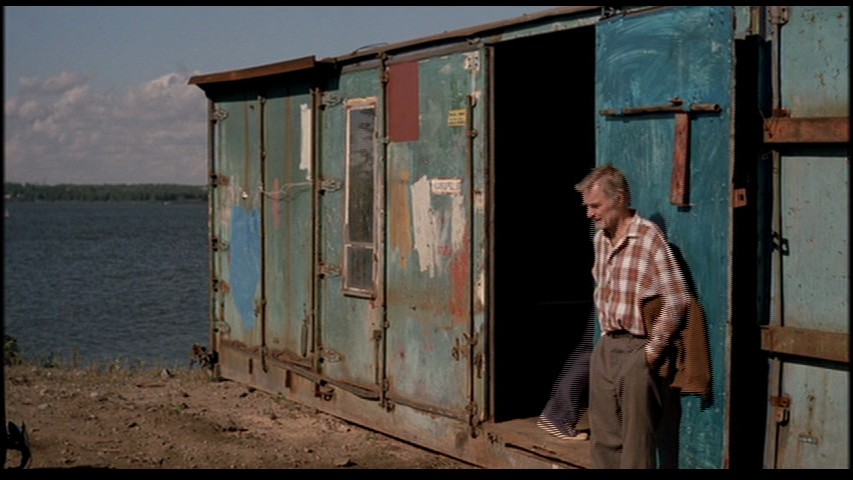
Figure 4
In the container world, scrap materials are salvaged, an old mangle washing machine
with a roller for squeezing the water out of clothes is actively employed, and the
Salvation Army runs a thrift shop, as well as a soup kitchen. The protagonist, M,
discovers a discarded juke box, and this sets in motion a series of events that change
the lives of all the characters. M himself is a found object, and his journey highlights
for the audience the inherent value of found objects discovered within the amnesiac
present. While M has no recollection of his personal history or of having had a previous
attachment to such an object as the juke box, nor shows any particular interest in
the specific history of any found object, he does recognize the potential and utility
of a found object. M discovers that meaning and pleasure can be derived by putting
what has been discarded and forgotten into use again.
M is not alone in being resourceful, however. Found objects put to use in Mies vailla menneisyyttä include the shipping containers, an improvised shower made from an oil drum, and
an oil can (perhaps a garden watering can) used as a kettle. This incorporation of
the industrial into the domestic can also be found, in starker instances, throughout
the worker’s trilogy and other films. For example, the title character in Tulitikkutehtaan tyttö [The Match Factory Girl] lives in Factory Lane and uses a length of galvanized pipe as a closet rod, albeit
without a closet.
Clothing, too, is found and recycled in Mies vailla menneisyyttä: besides the exchange of shoes mentioned above, M salvages clothing from the container
that he occupies, whose former tenant has expired. Also, the Salvation Army’s thrift
shop figures prominently in the film and is the source of M’s improvements in wardrobe.
Both examples echo events in Ariel, where the title character takes up temporary residence at an urban mission homeless
shelter, and acquires a much-needed winter coat from a dumpster, later learning that
it belonged to a forklift driver killed on the job.
The used car also constitutes a category as a “readymade” found object. M avails
himself of the night watchman’s car, a vintage station wagon
(of sorts), and a second vintage vehicle is driven by another pivotal character.
The presence of these cars contributes to the peculiar atemporality of the film: the
abundance of material objects from earlier times, the desperate economic conditions,
the eclectic music samples from various eras, and Kaurismäki’s saturated colour palate
all generate a certain cinematic temporal suspension. We might be in a Depression-era
Capra film, albeit one captured in Technicolor, and the functioning, anachronistic
automobiles contribute to this effect.
Overall, mobility in Kaurismäki’s cinematic world is frequently fugitive and requires
an automobile, typically a used, vintage U.S. model. The mission of the fourteen
men named Frank in Kaurismäki’s early, absurdist comedy Calamari Union (1985) is facilitated for one of the Franks by riding through Helsinki on the hood
of a car appropriated in traffic; a convertible inherited from a suicidal miner is
driven with the roof down through most of the winter in Ariel, the button for closing the roof only being discovered by a dying man in the last
few minutes of the film; the road trip in Pidä huivista kiini, Tatjana [Take Care of Your Scarf, Tatjana] (1994) is accomplished in a vintage car accessorized with both a coffee maker and
a 78 rpm record player; Soviet-era tractors and a succession of old U.S. cars in Leningrad Cowboys Go America (1989) are employed in the band’s beneath-the-radar, international tour; and a bizarre,
three-wheeled, 1970s-era Robin Reliant automobile figures significantly in La vie de bohème (1992). In addition, the predatory figure of the used car salesman is a recurrent
figure in Ariel, Leningrad Cowboys Go America, La vie de bohème and Kauas pilvet karkaavat, as economic circumstances force the protagonists to sell or purchase their cars
at a loss.
Jukeboxes, portable radios, and vintage record players are a significant presence
in many Kaurismäki films, and are representative of one of the key elements in the
Kaurismäki universe: music. In Varjoja paratiisissa, the protagonist, Nikander, finds an old blues LP during his rounds as a garbage
man; in Leningrad Cowboys Go America, the eponymous band collectively discovers the genre of rock-’n’-roll via LPs; the
jukebox in Mies vailla menneisyyttä has a similar effect on the Salvation Army band, winning them over to a new musical
genre that, M argues, can be employed in the saving of souls. It is worth noting
that this jukebox is discovered by M at an un-reclaimed industrial site: the jukebox,
a mattress and a small refrigerator sit in a surreal emptiness (Figure 5). It is
a comic and ironic demonstration of Zuhandenheit: everything that M needs for his new home is waiting for him.
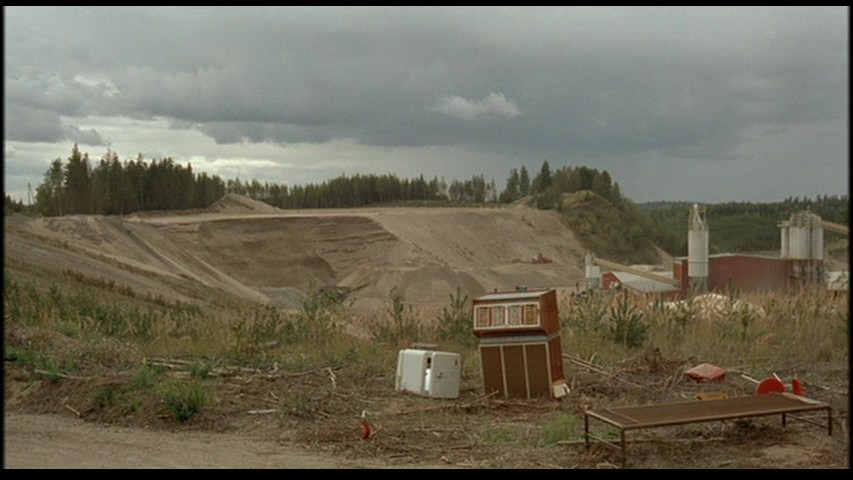
Figure 5
A more devastating sense of surreal juxtaposition is created in Tulitikkutehtaan tyttö, where the female protagonist finds momentary refuge in a small apartment (Figure
6). She sits forlornly in a corner by a window, dwarfed by the incongruous presence
of a jukebox and a pool table in an otherwise domestic interior.
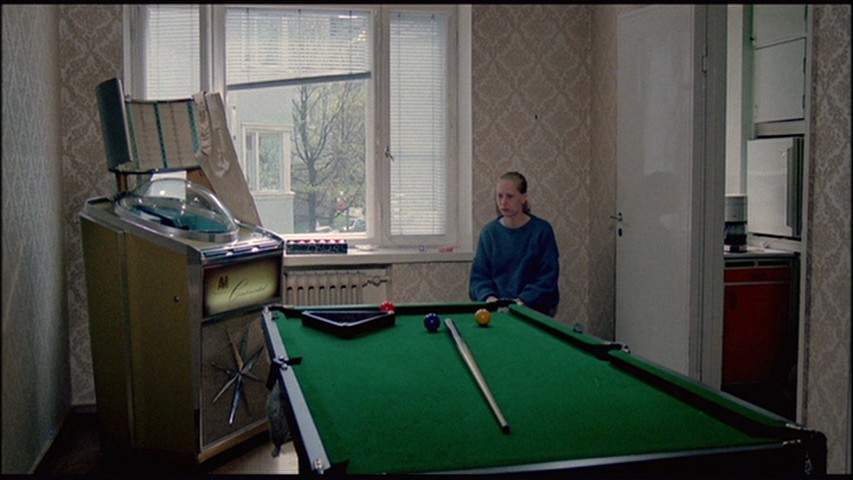
Figure 6
Chief among the examples of music as a found object, and supporting the idea of a
master-film or collective work-in-progress, is the veritable leitmotif that Kaurismäki has created in employing recurrent excerpts from the fourth movement
of the Pathétique Symphony, no. 6 in B minor, op. 74, by Peter Ilyich Tchaikovsky. An excerpt from
this movement is first used in Ariel, and then subsequently and in consistent association with the characters played by
Kati Outinen in Tulitikkutehtaan tyttö, Pidä huivista kiini, Tatjana, and Kauas pilvet karkaavat. Typically, this leitmotif indicates a desire for escape or release and accompanies the protagonist at a moment
of emotional vulnerability, even fragility. It plays on the radio in a scene in Ariel where the protagonist arranges to purchase false passports from dangerous criminals;
it again comes on the radio as Outinen’s character in Tulitikkutehtaan tyttö momentarily has second thoughts while waiting for the rat poison that she has served
to her mother and stepfather to take effect; it underscores the moment in Pidä huivista kiini, Tatjana when Reino and the title character played by Outinen have their first moment of awkward
intimacy sitting on a desolate loading dock; and it accompanies the struggles of Outinen’s
character and her husband, both unemployed and middle-aged, in Kauas pilvet karkaavat. Thus, this recurring motif derived from the fourth movement of the Pathétique constitutes a found object.
It is further worth noting that the excerpt is derived from pre-existing recordings,
hence an employment of found objects on the part of the filmmaker in keeping with
the sorts of activities his characters frequently engage in. Thus, the LP as a mechanically
reproduced found object serves in the films as a property within the mise-en-scène, as a diegetic source of music, and as the most frequent source of non-diegetic music
in the production of the films themselves. Kaurismäki has stated that he particularly
enjoys mixing the music for his films while editing “alone—really alone,” and that
“I always have some tunes in my head and then I take a pile of records into the editing
room” (Cardullo 6). Thus, in the editing process, musical memory and found objects
play a significant
role in Kaurismäki’s work method.
Found-ness with respect to personnel, personae, and memory
Thus far, I have presented examples of found objects within the diegesis of the various
films. However, what delimits the “readymade”? In this section of the essay, I will
consider the scope and applicability of the
concept of found objects, found-ness, and the creative processes that involve “finding”
as a form of Zuhandenheit in the films of Kaurismäki. This extends the category of “found object” to include
actors, characters and recurrent personae, animate beings that are also
“products” within the context of Kaurismäki-land as a fiction as well as within a
set of films
manufactured and mechanically reproduced as part of the national and international
cinema industry.
A dramatic device that is typical of five of the films in the sextet involves violent
acts that reduce the male protagonist to the status of a found object. With the exception
of Tulitikkutehtaan tyttö, whose sole protagonist is female, all the films include a sequence in which the
male protagonist is beaten into unconsciousness: in Varjoja paratiisissa, Nikander is knocked out with a board and left exposed overnight, being found by
garbage men the next day (Figure 7); in Ariel, Kasurinen is knocked out with a bottle, robbed and, again, left exposed to the elements
overnight (Figure 8); in Kauas pilvet karkaavat, Lauri is beaten by gangsters and left unconscious in a shipyard with stacks of shipping
containers in the background (Figure 9); in Mies vailla menneisyyttä, M is also robbed and knocked unconscious (Figure 10); and in Laitakaupungin valot, Kostinen is beaten nearly to death after attempting to stab a criminal kingpin,
and is subsequently “found” and recovered by two other marginalized characters (Figure
11). In each film, this
reduction of the human being to an unconscious, object status also marks a turning
point in the male protagonist’s trajectory. In both the literal and Heideggerean
sense of the word, the protagonist is “thrown” into a new existence; consequently,
he begins to take new kinds of actions toward
others. Because these episodes are so characteristic of Kaurismäki’s dramaturgy,
because these beatings seem possible, in part, due to the economic status and relative
powerlessness of the protagonist, and because the consequences of the violence are
depicted visually in images of the unconscious human form, the beaten insensate proletarian
seems to me to be a category of found object within Kaurismäki-land.
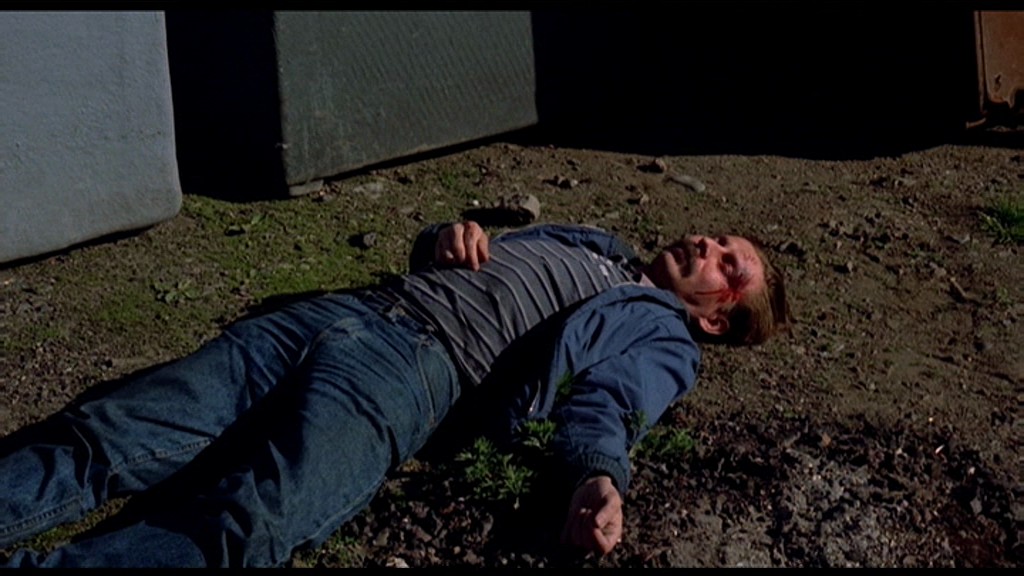
Figure 7
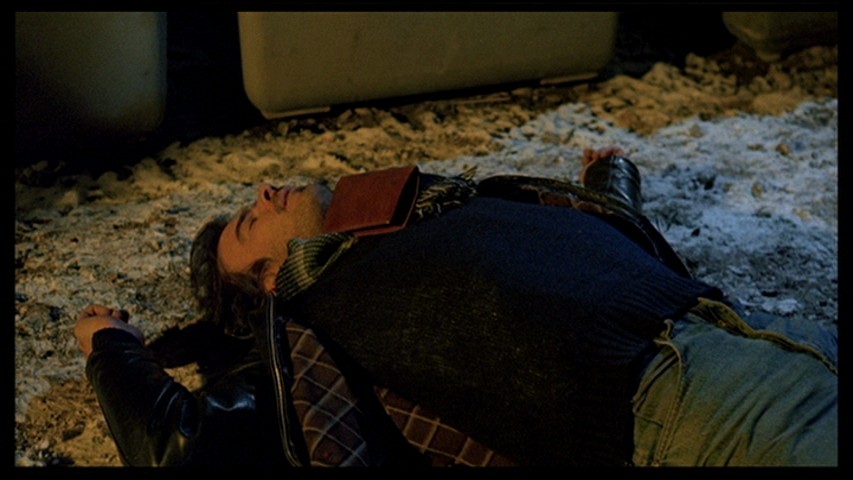
Figure 8
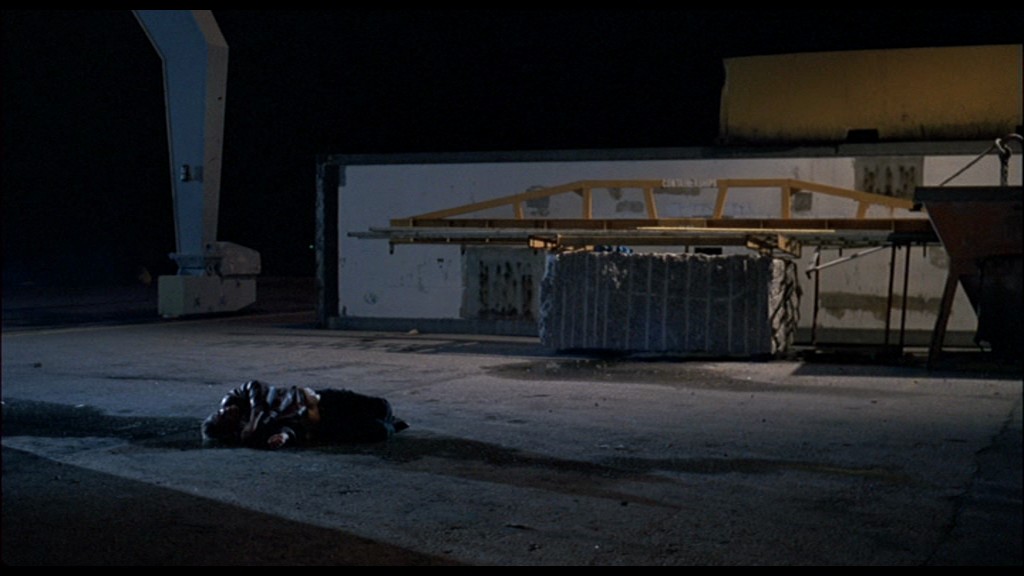
Figure 9
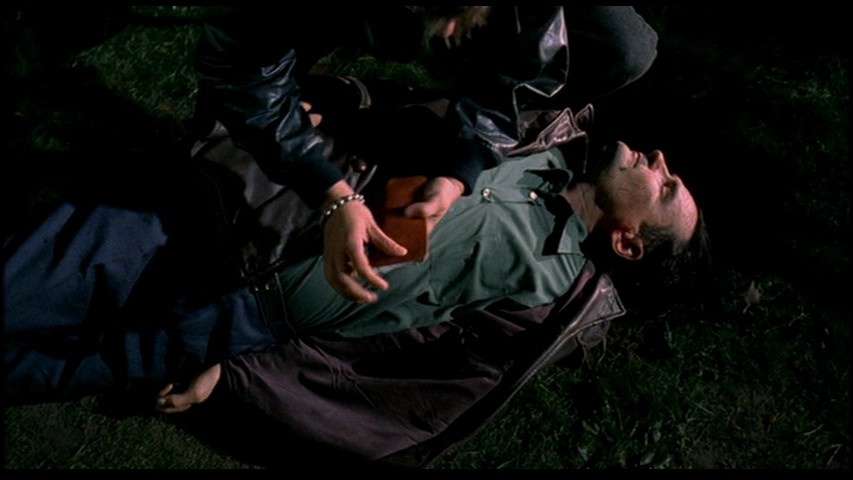
Figure 10
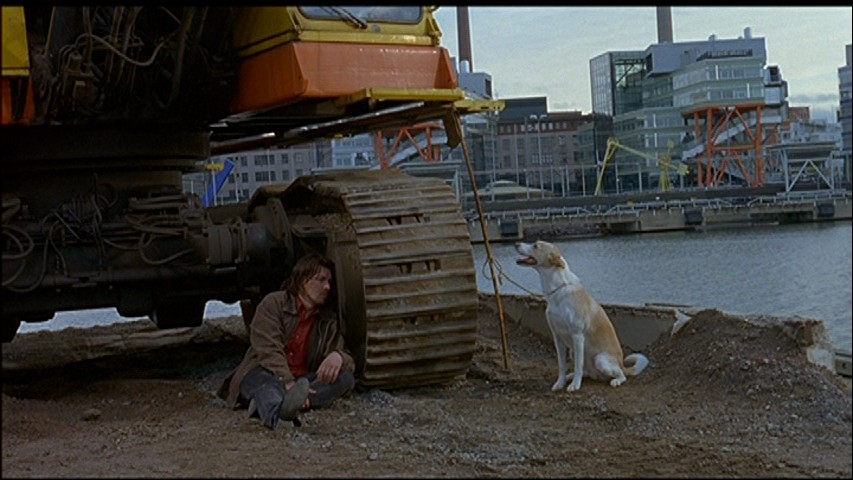
Figure 11
Human participation in and circumscription by industrial and post-industrial economics
is a recurrent concern in Kaurismäki’s films. This necessarily involves the existential
tension between personhood as something that is potentially free and volitional, and
personhood as something that is bound to labour, to consumption, and as a product
itself in various ways; this tension is often fundamental to the plots of the films.
An emphasis on the marginality and eventual disappearance of the working class persists
throughout much of Kaurismäki’s work, receiving its fullest treatment in the story
of the amnesiac M in Mies vailla menneisyyttä. Kaurismäki explains the significance of the protagonist’s initial: “En finnois,
‘M’ est la première lettre commune aux trois questions fondamentales ‘pourquoi,
quand et où,’ comme le ‘W’ en anglais (‘why, when, where’)” [In Finnish, ‘M’ is the
first letter common to the three fundamental questions, ‘why,
when, and where,’ as is the ‘W’ in English] (Cieutat and Ciment 17, my translation).
This statement also points out a strategy of linguistic reduction in Kaurismäki’s
work, which is often characterized as reticence and attributed to the behaviour of
“Finnish” characters. But, there may be more than “Finnish” national character in
this stance toward discursive dialogue. Reticence is part
of Kaurismäki’s creative strategy.
When an interviewer observed that the filmmaker is laconic in both his films and interviews,
and then asked if he is also that way in life, Kaurismäki responded: “C’est le seul
style que j’ai; si je le perds, je n’ai plus rien!… Je crois qu’il y a dans le monde trop de sons, trop d’images, trop de mouvement,
trop de mots” [It’s the only style that I have; if I lost it, I wouldn’t have anything!… I believe that, in the world, there are too many sounds, too many images, too much
movement, too many words] (Ciment and Herpe 10, my translation). This assertion,
which has much in common with the aesthetic of other filmmakers,
such as Ozu, Bresson and Bergman, also demonstrates a certain affinity with Heidegger’s
assertion that “with the essential words of language, what they genuinely say easily
falls into oblivion
in favour of foreground meanings” (1977 326). By reducing speech, Kaurismäki may
be restoring what is genuine and essential to
the “foreground meanings,” as in his use of “M” for the protagonist in Mies vailla menneisyyttä. This is an almost allegorical reduction, as essential meaning becomes embodied
and, thus, literally foregrounded. “M” embodies basic questions put to life anew in
a “thrown” existence that has no recourse to habitual answers, i.e. memory.
Speech, including names, and music seem to be aural components in this process of
reduction and foregrounding, which ultimately is linked to “readymades”. In connection
with the presence of the andante theme from Tchaikovsky’s Pathétique discussed above, there is also a recycling of the persona created by Kati Outinen,
as well as a curious assonance among the names of Outinen’s characters within the
sextet: Ilona, Iris, Ilona, Irma and Ilona are the respective heroines played by Outinen
in Varjoja paratiisissa, Tulitikkutehtaan tyttö, Kauas pilvet karkaavat, Mies vailla menneisyyttä, and Laitakaupungin valot. In addition, the female protagonist in Ariel, the second of the “loser” films, is named Irmeli. Given the similarity among the
names of these characters,
the typical plot device of a chance encounter bringing these characters into contact
with the male protagonists, and the consistent use of Outinen, the female protagonist
is almost always a found person in Kaurismäki’s cinematic world. This character is
always discovered, while the persona is continually recycled through a creative process
that allows for both recognition and forgetting. In short, throughout the films there
seems to be a kind of productive amnesia that is analogous to the trajectory of M
in Mies vailla menneisyyttä.
As with Outinen’s variations of the Ilona character, there is a re-employment of both
actor and character in Markku Peltola’s performance as M. Once the state has identified
him, M turns out to be one Jaakko Antero Lujanen. Lujanen is also the name of the
alcoholic and sporadically violent chef played by Peltola in Kauas pilvet karkaavat. Furthermore, the washroom attendant who first reports M as a dead man identifies
himself as “Lajunen” over a walkie-talkie; this peculiar doubling in names underscores
the twin features
of interchangeability and repetition that seem to persist throughout the sextet: personae
remain somewhat constant, but they shift locales with no memory of their previous
instantiations or incarnations in other films; nor do they recognize their prior relationships
to other re-cycled characters. For example, in Kauas pilvet karkaavat, in addition to Lajunen and Ilona (as well as the ghostly trace of the actor Matti
Pellonpää, which I shall shortly discuss), there is also a character named Melartin.
Melartin is played by the actor Sakari Kuosmanen, another of Kaurismäki’s longstanding
collaborators. Kuosmanen also played Melartin in Varjoja paratiisissa, the first film of the two interlocking trilogies. Yet, the history shared between
these two instantiations is seemingly forgotten by character, actor and filmmaker
alike. This is yet another case of the recycling of character, name and persona, interlinking
the films of the sextet.
Beyond being the stuff of fan trivia, this forgetfulness is an indication of a kind
of creative amnesia within the sextet and the collective work in general: characters
and actors seemingly float, are rediscovered in new contexts and given alternate existences
within the collective work-in-progress. Again, the concept of a found object is applicable
to this process of manufacturing, discarding and re-employing characters and actors.
And amnesia, or at least a half-forgetting, seems to be both a theme within the films
and a part of Kaurismäki’s creative process.
Memory, amnesia, persona and found objects are apparent in Kaurismäki’s longtime working
relationship with actor Matti Pellonpää, who appeared in the first two films of the
“loser” trilogy, as well as earlier and subsequent films, and who was to appear in
Kauas pilvet karkaavat. However, Pellonpää died somewhat unexpectedly before filming commenced. In discussing
the persistence of Pellonpää’s persona in his films, beginning with the role of Nikander
in Rikos ja rangaistus (1983), an adaptation of Dostoevsky’s Crime and Punishment, Kaurismäki stated, “That was my first picture, in 1983; that was the first time
I started to develop the
loser character Nikander. Right up to Tatjana he’s the same character” (Romney 13). Thus, Pellonpää’s performances as Nikander
in Varjoja paratiisissa and Mikko in Ariel, the first two “loser” films, as well as his roles as Rodolfo in La vie de bohème (1992) and Reino in Pidä huivista kiini, Tatjana (1994), are the trajectory of a single persona, the Nikander persona.
This is confirmed by Kaurismäki in discussing Kauas pilvet karkaavat: “Originally I was going to make its characters the same as in Shadows in Paradise. I would have made reference to the same character—Matti Pellonpää would have been
Nikander, Kati Outinen would have been Ilona, ten years later. But I don’t have Matti
anymore so I had to give up on that idea” (ibid.). However, if one looks backwards
from the vantage point of Laitakaupungin valot, it appears that Kaurismäki never quite gave up on that idea.
Pellonpää does in fact appear in Kauas pilvet karkaavat: the photograph of the boy in the couple’s home, a child that they have presumably
lost to death, is that of the actor as a youth (Figure 12). Furthermore, the character
Ilona visits a cemetery at one point in the film, and stands by a gravestone that
may be Pellonpää’s. A photograph of the actor as an adult is subsequently featured
in a scene in Mies vailla menneisyyttä. Thus, while the actor originally associated with the Nikander persona has died,
this passing generates a certain narrative device that extends throughout the first
two films of the Finland trilogy.
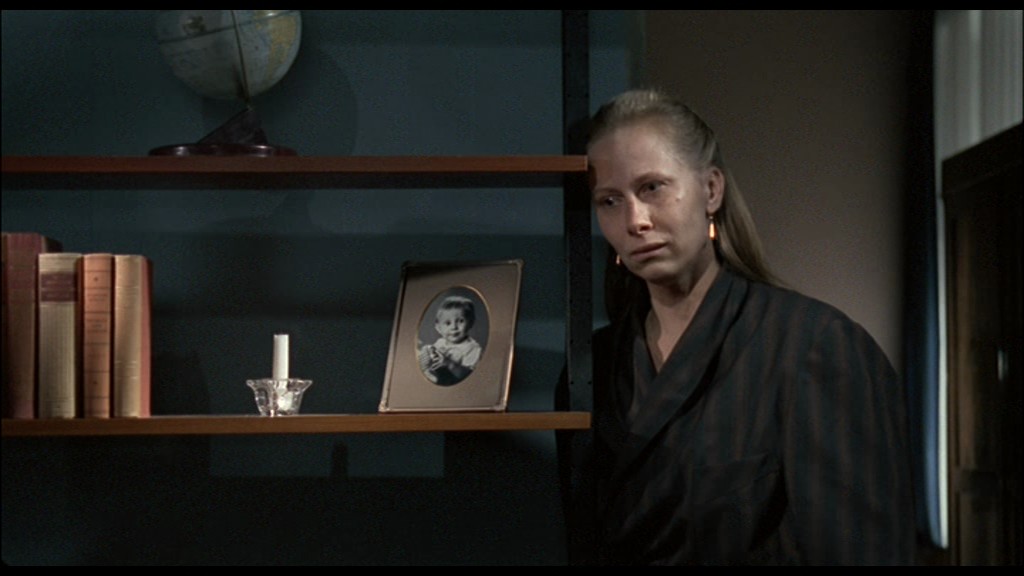
Figure 12
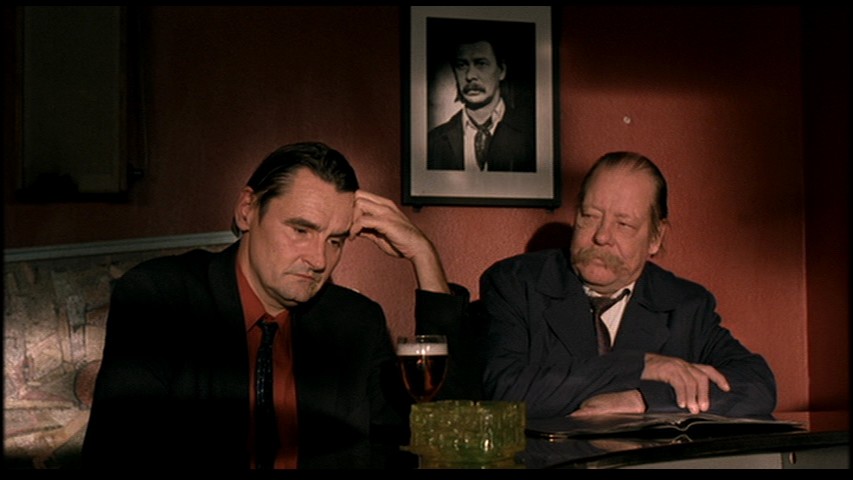
Figure 13
This inclusion of the photograph of Pellonpää in the film exemplifies the use of readymades
in Zuhandenheit. The placement of the historical photograph (as opposed to an actor) within a fictional
setting is significant in a number of ways and on a number of levels. First of all,
in terms of intent, both this photograph and the photo of Pellonpää as an adult in
Mies vailla menneisyyttä discussed below are found objects used in homage (Figure 13). But this homage, which
is an example of Zuhandenheit, accesses potentials in the original photographs that were only latent: both photographs
were manufactured as commemorative documents, in a sense, but not designed for elegiac
purposes. Second, in the case of the childhood photo, this particular found object
brings an historical domesticity into our view via a fictional domesticity. Within
the context of the shooting of the scene, it is a set property that has the potential
to evoke emotional and psychological repercussions for the actor (Kati Outinen) that
are extra-diegetic. Outinen and Pellonpää were frequent collaborators under Kaurismäki,
and this particular sequence required Outinen to play opposite Pellonpää in new ways,
both posthumously and also historically, as it were, in that the photo is that of
Pellonpää from a time before the two actors knew one another. It may well be that,
at the moment of shooting, Outinen was not concerning herself with the photograph
as an historical image of Pellonpää, but endowing it with a fictional history drawn
from her character’s perspective; nevertheless, the photograph’s historicity is a
material fact present within the imaginative processes of the actor. Third, both photographs
are studio portraits belonging to a genre of photography geared toward popular consumption,
particularly in the case of child photos. While intended for display and to function
as a memento (or, in the case of the portrait of Pellonpää as an adult, perhaps for
professional purposes), neither photo was created for inclusion within a film, with
thought given toward the possibility of an untimely death, or, in the case of the
childhood studio portrait, with anticipation of a career as an actor. They are, therefore,
manufactured products used within new contexts and for new purposes that, despite
their generic origins, serve to evoke a specific, auratic presence. Fourth, the childhood
photograph, rather like an actor, but closer in some ways to an animal performer,
such as a dog, is a surrogate: a real thing used in place of a fictitious object (a
character), surrounded by a mimetic performance but not capable of participating in
the mimesis. As an object included within the mise-en-scène, it has an enhanced and privileged placement, but it also represents a character:
it thus invokes a being with a singular presence. Other kinds of performances or performers,
such as the various dogs in Kaurismäki’s films (inter-related and belonging to the
director), the recorded musical performers, or the performances of characters in states
of unconsciousness, share something with these photographs in terms of both aura and
object-ness. Fifth, the childhood photo included within a fictional domestic setting
is important not only as a representation of the living space of the characters, but
also in its disclosure of the lived experiences and relationships that are drawn upon
in order to construct that fictional space. The lives of the director, actors and
crew members who knew Pellonpää are also imbricated within the scene, and the presence
of this community experience used, along with the photograph, to create a domestic
interior brings us again to the existential concern with dwelling that seems to permeate
Kaurismäki-land.
The status of the art object and its institutional relationship to an audience are
called into question in gallery settings by Marcel Duchamp and cinematically by Kaurismäki,
perhaps with similar purposes but to different effects. The readymade, found object is frequently used in Zuhandenheit by the director to resist the very economic forces that gave rise to the readymade
object in the first place. The difference between participation and resistance lies
in the use of such objects in a manner that discloses their relationship to authentic
existence. This existence is captured, felt, and yet left without narrative explication
in the image of Ilona/Outinen beside the framed studio portrait of the unidentified
son/Pellonpää; this photo, in turn, resides among the other objects on the bookshelves—the
unlit candle, the closed books, the globe of the world, and the emptiness lying between
all of these objects.
With this memorial aspect so present in Kauas pilvet karkaavat, it is interesting that the theme of amnesia prevails in Mies vailla menneisyyttä. Even though the photograph of Pellonpää is present in the latter film, no character
looks directly at it or otherwise acknowledges its presence (Figure 13). The scene
in which the photograph appears and the plot sequence it belongs to concerns the righting
of wrongs and the paying of debts, i.e. acts of ethical remembrance. A dispossessed
construction contractor-turned-bank-robber enlists the assistance of M to deliver
a set of envelopes containing back-pay to former employees. M agrees to do so, and
the contractor subsequently commits suicide. As far as conception and agency are concerned,
real memory is extinguished while the obligations of that memory are entrusted to
an amnesiac. The lack of acknowledgement of Pellonpää’s photograph is thus thematically
as well as behaviourally appropriate within the context of the film; a new actor,
Markku Peltola, has taken on the Nikander persona, but without a history of having
played Nikander, nor any cognizance of having been Nikander.
The inclusion of these historical photographs of Pellonpää opens up another question:
What is Kaurismäki’s relationship to the real world? Within the fiction of his collective
work, the real world persists in documentary fragments that can be considered found
objects. In Tulitikkutehtaan tyttö, the television carries news coverage of the death of Ayatollah Khomeini, a disaster
on the Trans-Siberian railway and the suppression of the student uprising in Tiananmen
Square. Regarding Pidä huivista kiini, Tatjana, Kaurismäki says, “Comme tous mes films, c’est une sorte de documentaire sur les
changements culturels
dans notre société” [Like all my films, it’s a sort of documentary on the cultural
changes in our society] (Ciment and Herpe 10, my translation). Romney observes that
Kaurismäki’s films do not seem to take place in the present
or in a real place, although located in the real world because of references to recent
events, such as the television reportage on the death of Ken Saro-Wiwa and other Nigerian
activists in Kauas pilvet karkaavat. Kaurismäki replied that he includes such events so that they will not be forgotten:
“Cinema shouldn’t be only for entertainment” (Romney 12). In various articles, he
has spoken of the ethical imperative that drove him to make
Kauas pilvet karkaavat as a response to the unemployment in Finland following the bank crisis in the 90s
(Ciment and Herpe 9, Romney 12). At the same time, however, he acknowledged that if
the film did not have a Capra
ending, it would realistically end in a double suicide (Ciment and Herpe 8). Thus,
even within what Louvish has observed as a stylistic shift “edging us away from realism
and towards a kind of never-never-land” (Louvish 26), Kaurismäki continues to preserve
those bits and pieces of the world that, in his
view, should be preserved and re-evaluated.
Found processes, Bergman’s old Arriflex and existential disclosure
In the interviews that I have found, Kaurismäki’s acknowledgement of Scandinavian
directors has been limited to Carl Th. Dreyer and Ingmar Bergman. From Bergman, the
legacy is explicitly material; in fact, it is more of an acquisition, or even an outright
purchase, than an influential inheritance. In 1989, while preparing to shoot his two
next films, La vie de bohème and I Hired a Contract Killer, Kaurismäki told interviewer William Fisher, “I already have the camera: I have Ingmar
Bergman’s old Arriflex. After Fanny and Alexander,
he gave up making films so he sold his camera to me” (Fisher 254). In fact, Kaurismäki
may have used this camera to shoot Ariel in 1988, as the Arriflex brand is listed for the first time in the end credits. Taking
possession of Bergman’s camera is significant and typical of the found objects that
appear in the films of Kaurismäki. The legacy is material and mechanical, an object
with a past that can be re-employed in the manufacturing of a personal cinema, just
as the numerous found objects in the films are re-employed to create an enhanced existence
for the characters that find them.
In the final film of the sextet, Laitakaupungin valot, the Depression-era desolation of the earlier films gives way to a sleek emptiness
described by Ginette Vincendeau “as an empty desert of gleaming glass and metal where,
in typical postmodern fashion,
different levels of society coexist but don’t connect.” There remain in the protagonist’s
apartment, however, the familiar found objects
of the earlier films: a vintage record player, the old cups and plates, the ready-mades
accompanying a life lived on the margins, or perhaps more aptly, what Vincendeau calls
“the interstices of the new social order” (ibid.).
But Laitakaupungin valot also marks another kind of new order, a generational shift in Kaurismäki’s master-project.
The principal characters are twenty years younger and played by a new generation of
actors. Most of the familiar faces are gone, and Kati Outinen appears briefly as a
checkout clerk in a supermarket, the occupation of the character in her first role
with Kaurismäki in Varjoja paratiisissa (Figure 14). While the character is listed simply as “supermarket cashier” in the
end credits, a small nametag to the uniform that Outinen wears in the scene
reads “Ilona”—the same name as Outinen’s first role in Varjoja paratiisissa and again in Kauas pilvet karkaavat (Figure 15).
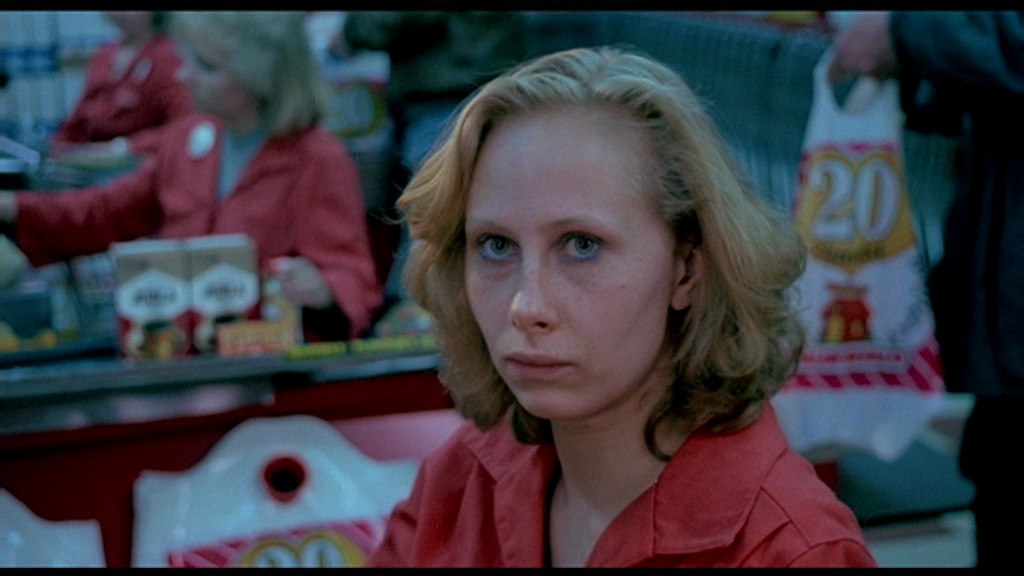
Figure 14
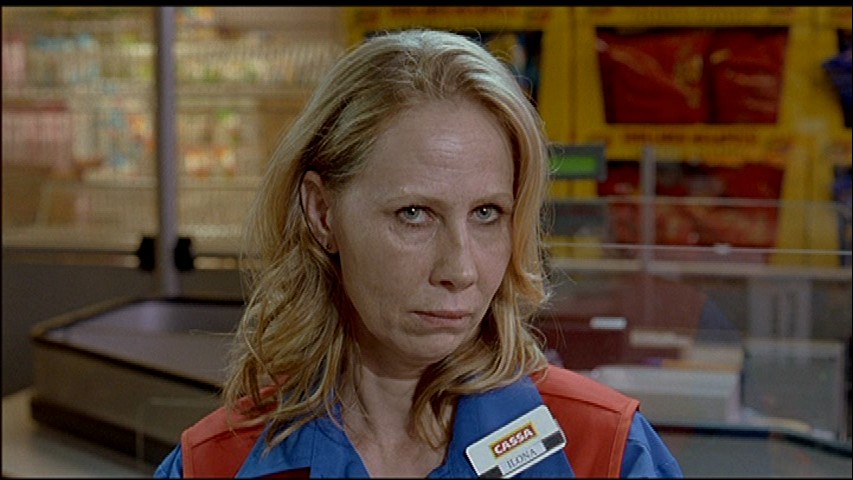
Figure 15
This marginal (or marginalized) re-appearance of Ilona/Outinen affirms that the “loser”
and Finland trilogies do in fact comprise a sextet: beginning with the story of the
Nikander persona and Ilona in the first film, developing Outinen’s persona in the
third film, passing though a process of mourning for and forgetting Nikander/Pellonpää
in the fourth and fifth films, and then the virtual forgetting of Ilona in the sixth
film. Seen in this light, the sextet is a found project, half of which was shot with
a found camera, “Bergman’s old Arriflex,” illustrating the use of found objects and
the creation, recovery and loss of found
personae. In addition, the development of the sextet was influenced by those found
films, principally from the 1940s and 50s, that Kaurismäki appropriated to his own
time and sensibilities.
If all building is concerned with dwelling, the manufacturing of objects used to furnish
living places may also be considered an aspect of building. Thus, such objects, particularly
“readymades” (from LPs to shipping containers), disclose this human concern with dwelling
in all
building efforts. Heidegger points to a “threefold fact” disclosed in the essential
meaning of Bauen: first, “Bauen ist eigentlich Wohnen” [building is really dwelling]; second, that
“Das Wohnen ist die Weise, wie die Sterblichen auf der Erde sind” [Dwelling is the
manner in which mortals are on the earth]; and, third, “Das Bauen als Wohnen entfaltet
sich zum Bauen, das pflegt, nämlich das Wachstum, —und
zum Bauen, das Bauten errichtet” [Building as dwelling unfolds into the building that cultivates growing things and the building that erects buildings] (2000 150; 1993 350, my emphasis). M, as a welder, has already participated in the
second aspect of unfolding, the building that erects buildings; his progress in Mies vailla menneisyyttä clearly emphasizes dwelling in the sense of the building that cultivates growing things, i.e. gardens, dogs, love, music and communal gatherings.
In the film’s final sequence, we see a sheltered community established that is protective
of its members, one in which man and woman (M and Irma) are consecrated, and the people
are finally grounded: “Das gekennzeichnete Bauen ist ein ausgezeichnetes Wohnenlassen” [Building
thus characterized is a distinctive letting-dwell] (2000 161; 1993 360). In this case, the “letting-dwell” has been learned through found objects and readymades,
from LPs to shipping containers,
and the lessons have resulted in authentic community, relationships and individuality.
Something has been prepared for these people, an existence in accord with Heidegger’s
final assertion: “Nur wenn wir das Wohnen vermögen, können wir bauen” [Only if we are capable of dwelling, only then can we build] (2000 162; 1993 361, original emphasis). Appropriately enough, as M and Irma leave
the community concert and walk off into
an industrial cityscape, a freight train rolls past in the foreground. While we lose
sight of the couple as a result, we also see freight cars loaded with shipping containers
pass before us. The containers themselves have been restored to their appropriate
place in the world. This reinforces the possibility of a new phase of dwelling, at
least within the cinematic realm of Kaurismäki-land.
However seriously one might seek to interpret Kaurismäki, he will always manage to
deflate himself and his work. In considering the aesthetics of pastiche in Kaurismäki’s work, a concept related to found objects, Anu Koivunen points out
the inherent duplicity in the form: “On the one hand, pastiche is deeply involved
in its object; on the other, an awareness
of artifice and imitation haunt all claims of certainty” (Koivunen, citing Richard
Dyer, 145). This kind of “haunting” characterizes M, Mies vailla menneisyyttä, the sextet and Kaurismäki’s work as a whole. Yet the cinema that he creates provides
us with a sort of productive nostalgia that is two-pronged: a creative discomfort
generated by the film before us and the associative comfort of the other films that
are evoked or recalled. In addition, a Kaurismäki film preserves specific, historical
moments, such as Tiananmen Square or the execution of Ken Saro-Wiwa, while generating
the new memory of the film itself. This memory is established, as I hope to have shown,
through the creative “implementation” of found objects on various levels: diegetically,
aesthetically, inter-textually,
practically (as in the use of Bergman’s old Arriflex) and, finally, through the processes
of mechanical reproduction that give us cinema. The friction between this world of
“readymades” and authenticity is an existential irony that Kaurismäki confronts with
melancholia
and humour: “My films have no reason to exist. Not at all. But I have to cope with
my ambitions:
I can’t just stand there being lazy — I’m a hardworking man” (Romney 12).
NOTES
- Anu Koivunen attributes this schism to an “ambivalent rhetoric” generated by Kaurismäki’s mixture of “national sentiment, politics and irony” (133-34). I would add that the employment of found objects in the action and mise-en-scène registers differently for Finnish and non-Finnish audiences, and may also be a part of this “ambivalent rhetoric.” To me, this is not just a matter of “getting it” versus “not getting it”; it is a consequence, in part, of a found object’s effect on a spectator’s perception. In some cases, the object itself bridges national cultures, as with shipping containers, automobiles, record albums, etc., which are a part of global commerce and internationalized popular culture.
-
Koivunen notes that Kaurismäki’s “ambivalent affective rhetoric” evokes associations with pastiche and retro, concepts which “highlight the presence of many temporalities” and generate a sense of temporal, material, stylistic and experiential fluidity, as well as “ambivalence and insecurity.” Koivunen includes these concepts within Miriam Hansen’s broader notion of “vernacular modernism” to account, in part, for Kaurismäki’s international appeal (135-36).John Sundholm specifically addresses this phenomenon with respect to Kaurismäki’s silent film Juha (1999). Sundholm describes the film as unfolding in a “fictive epoch” evoking the 1950s, into which Kaurismäki “introduces objects which are ‘out of time’” such as a microwave oven and contemporary currency (215). For Sundholm, Kaurismäki creates a “condensed history” problematizing “the issue of history and memory” (217-18). In such an approach, the viewer experiences “the epoch via objects and things.” Thus, one need not experience the past; rather we only have to reflect on it “through such objects” (220). In discussing Juha, Sundholm sees some objects as belonging to the fictive epoch and others as anachronistic; however, in the films under consideration here, I find such temporal clashes appropriate to the processes of existential discovery that Kaurismäki’s protagonists routinely undergo within their world(s). These seem to me to be phenomenological encounters (undergone in a wry and ironic spirit) disclosing a world that is, in actuality, no less jarring than our own.
- The influence of existentialism on many of the films and filmmakers that Kaurismäki has referred to in numerous interviews is in large evidence, and comparisons between Kaurismäki and playwright Samuel Beckett, who is commonly considered an existentialist, are also made (see Louvish 26). Rather than establishing a strict intellectual lineage for Kaurismäki, however, I would argue that certain ideas “float” or at least circulate (not unlike found objects). Persistent circumstances and concerns may draw philosophers, artists and salvagers alike toward similar conclusions and methods. I see Heidegger’s thoughts on dwelling and his idea of Zuhandenheit as particularly relevant to the themes and processes that Kaurismäki undertakes in Mies vailla menneisyyttä and the other films in the sextet, and worth considering without necessarily delineating any direct influence of Heidegger’s writings upon Kaurismäki’s thinking and film-making. Continental philosophy seems to me to be part of a common European cultural and intellectual milieu and therefore readily available to Scandinavian cinema.
- Andrew Nestingen discusses the specific legacy of the action and camera work for this sequence within Finnish film (2008 145-46). Kaurismäki’s extensive inter-textuality is discussed later in this paper as another instance of the employment of found objects.
- Anu Koivunen finds that this image of the two boys carrying water explicitly evokes Hugo Simberg’s “Haavoittunut enkeli” [The Wounded Angel] (1903), a painting well-known to Finnish audiences (135).
- Andrew Nestingen has generously pointed out to me that Kaurismäki made frequent statements about existentialism early in his career, and that two early films, Valehtelija [The Liar] (1981) and Arvottomat [The Worthless] (1983), both contain explicit reference to the French existentialist philosopher Jean-Paul Sartre. Furthermore, Kaurismäki wrote and directed an adaptation of Sartre’s play Les mains sales [Dirty Hands] (1948) for Finnish television, entitled Likaiset Kädet (1989). Sartre himself viewed Heidegger’s existential phenomenology as precedent for his own elaboration of existentialism in L’Être et le néant [Being and Nothingness] (1943), a view critiqued by William R. Schroeder (1984).
- Nestingen (2008) gives the fullest consideration of the shipping containers and their relation to economic conditions in Finland and globalization; see especially pp. 140-52.
- Kaurismäki uses the fragment from the fourth movement specifically in association with Outinen’s character in Kauas pilvet karkaavat, while employing excerpts from the first movement to underscore exchanges between that character and her husband.
- Additional examples of a musical piece used in more than one film by Kaurismäki are the English and Suomi versions of “My Heart Must Do the Crying” (1965). This song underscores the first kiss between the male and female protagonists in Varjoja paratiisissa and in Mies vailla menneisyyttä. See note 12, below.
- This is universally acknowledged by critics and scholars. Sakari Toiviainen summarizes: “Aki Kaurismäki’s characters understand each other without unnecessary words through the language of body, gazes, gestures or heart, or else they talk past each other. In any case, the most important is that which cannot be expressed in words, that which is to be seen in the images or heard in the music” (quoted and translated in Koivunen 143).
- For Kaurismäki, the critique of capitalism is a battle in a void: “Il est trop tard à mon sens pour opposer le méchant capitaliste au brave prolétaire. Aujourd’hui, l’ennemi est invisible, la technologie a pris le pouvoir. Si vous choisissez une compagnie comme Nestlé et que vous allez chez la maison mère, à Zürich ou ailleurs, et que vous montez au sommet de l’immeuble et ouvrez la porte du plus grand bureau, vous ne trouvez personne” [It is too late to my mind to oppose the merchant capitalist to the brave proletarian. Today, the enemy is invisible; technology has usurped the will to act. If you choose a company like Nestlé and then you go to the headquarters, in Zürich or somewhere else, when you ascend to the top of the premises and open the door of the grandiose office, you don’t find anyone] (Ciment and Herpe 10, my translation). In such a void, there is little hope. But there remain certain ethical and aesthetic values that Kaurismäki seeks to maintain, and even strengthen, in his film-making. In an amoral void, perhaps values themselves constitute found objects.
- There is also a musical reason to consider M as a continuation of the Nikander persona, this being the recurrent use by Kaurismäki of the song “My Heart Must Do the Crying” (1965) as a leitmotif. In Varjoja paratiisissa, the first kiss between Nikander (Matti Pellonpää) and Ilona (Kati Outinen) is underscored by a cover version of that song (“Salattu Suru” [1986] performed by Topi Sorsakoski & Agents); in Mies vailla menneisyyttä, the original English version, performed by The Renegades, accompanies an identical moment between M (Markku Peltola) and Irma (Outinen).
- While I have stressed those cinéaste directors cited most frequently by Kaurismäki in interviews, one must also include Finnish rillumarei films and Hollywood B-movies as significant influences from the 1950s.
- Anu Koivunen, citing Matti Peltonen, remarks that this sequence recalls “the many 1950s rillumarei films that championed a carnivalesque alliance of ‘ordinary people’ against ‘overlords’” suggesting a future of improved relations among human beings (Koivunen 139). Koivunen emphasizes an allegorical reading “suggesting an international community of those living at the margins of the nation-states” (ibid). One must always allow for Kaurismäki’s pervasive irony, of course.
REFERENCES
- Aknin, Laurent. 2004.
Aki Kaurismäki: La Lettre Volée.
L’Avant-Scène Cinéma 530: 3-6. - Amiel, Vincent. 1996.
Au loin s’en vont les nuages: Un monde froid, mais vivant.
Positif: Revue Mensuelle de Cinéma 428: 4-7. - Benjamin, Walter. 1988.
The Work of Art in the Age of Mechanical Reproduction.
Illuminations. Ed. Hannah Arendt. 1st Schocken paperback ed. New York: Schocken Books. 217-51. - Boujut, Michel. 2004.
Un artiste de la dignité.
L’Avant-Scène Cinéma 530: 1. - Cardullo, Bert. 2006.
Finnish Character: An Interview with Aki Kaurismäki.
Film Quarterly 59.4: 4-10. - Cieutat, Michel, and Michel Ciment. 2002.
Aki Kaurismäki: Je ne vois aucun avenir dans ce monde.
Positif: Revue Mensuelle de Cinéma 501: 16-20. - Ciment, Michel, and Noël Herpe. 1996.
Pas un cinéaste, mais un shaker de cocktail.
Positif: Revue Mensuelle de Cinéma 428: 8-11. - Fisher, William. 1989.
Aki Kaurismäki Goes Business.
Sight and Sound 58.4: 252-54. - Gili, Jean A. 2006.
Les Lumières du faubourg: Le choix de la solitude.
Positif: Revue Mensuelle de Cinéma 548: 22-24. - Goudet, Stéphane. 2002.
L’Homme sans passé: Les derniers des hommes?
Positif: Revue Mensuelle de Cinéma 501: 13-15. - Hartzell, Adam. 2003.
It’s Cold Out There: Thoughts on Take Care of Your Scarf, Tatjana.
Film Journal 1.6. http://www.thefilmjournal.com/issue6/tatjana.html (Accessed August 29, 2010) - Heidegger, Martin. 1960. Sein und Zeit. Tübingen: Max Niemeyer Verlag.
- ⸻. 1962. Being and Time. Trans. John Macquarrie and Edward Robinson. Malden, Massachusetts: Blackwell Publishing.
- ⸻. 1993.
Building Dwelling Thinking.
Basic Writings. Ed. David Farrell Krell. Revised and Expanded Edition. New York, San Francisco: Harper & Row, Publishers, Inc. 343-63. - ⸻. 2000.
Bauen Wohnen Denken (1951).
Vorträge und Aufsätze. Gesamtausgabe, Band 7. Frankfurt am Main: Vittorio Klostermann. 145-64. - Kaurismäki, Aki. 1985. Calamari Union. Perf. Matti Pellonpää Sakari Kuosmanen and Kari Väänänen et al. Villealfa Filmproduction Oy. Videodisc. Sandrew Metronome Distribution, 2005.
- ⸻. 1986. Varjoja paratiisissa. Perf. Matti Pellonpää Kati Outinen and Sakari Kuosmanen. Villealfa Filmproduction Oy. Videodisc. Sandrew Metronome Distribution, 2003.
- ⸻. 1988. Ariel. Perf. Turo Pajala Susanna Haavisto and Matti Pellonpää. Finnish Film Foundation.
- ⸻. 1989. Leningrad Cowboys Go America. Perf. Matti Pellonpää Kari Väänänen and Leningrad Cowboys (musical group). Esselte Video, Finnish Film Foundation, Finnkino Oy, Megamania, Svenska Filminstitutet and Villealfa Filmproduction Oy. Videocassette. Pref. Anonymous Orion Home Video, 1991.
- ⸻. 1990. Tulitikkutehtaan tyttö. Perf. Kati Outinen Elina Salo Esko Nikkari and Vesa Vierikko. Esselte Video, Finnkino Oy, Svenska Filminstitutet and Villealfa Filmproduction Oy. Videocassette. Kino Video, 1993.
- ⸻. 1992. La vie de bohème. Perf. Matti Pellonpää Evelyne Didi André Wilms and Kari Väänänen. Sputnik Oy, Pyramide Productions, Films A2, Pandora Filmproduktion and Svenska Filminstitutet. Videocassette. Kino International Corporation and Fox Lorber Home Video, 1994.
- ⸻. 1992. Those Were the Days. Perf. Leningrad Cowboys (musical group) and Kirsi Tykkyläinen. Sputnik Oy. Videocassette. Kino Video, 1993.
- ⸻. 1994. Pidä huivista kiini, Tatjana. Perf. Kati Outinen Matti Pellonpää Kirsi Tykkyläinen and Mato Valtonen. Finnish Film Foundation, Pandora Filmproduktion, Sputnik Oy and Yleisradio. Videodisc. Sandrew Metronome, 2005.
- ⸻. 1996. Kauas pilvet karkaavat. Perf. Kati Outinen Kari Väänänen Elina Salo Sakari Kuosmanen and Markku Peltola. Sputnik Oy. Videodisc. Sandrew Metronome Distribution, 2003.
- ⸻. 2002. Mies vailla menneisyyttä. Perf. Markku Peltola Kati Outinen Juhani Niemelä and Sakari Kuosmanen. Bavaria Film, Pandora Filmproduktion, Pyramide Productions, Sputnik Oy and Yleisradio. Videocassette. Columbia TriStar Home Entertainment, 2003.
- ⸻. 2006. Laitakaupungin valot. Perf. Janne Hyytiäinen Maria Järvenhelmi and Maria Heiskanen. Sputnik Oy, Pandora Filmproduktion, Pyramide Productions, BIM Distribuzione, C More Entertainment and Finnish Film Foundation. Videodisc. Strand Releasing Home Video, 2007.
- Koivunen, Anu. 2006.
Do You Remember Monrépos? Melancholia, Modernity and Working-Class Masculinity in The Man Without a Past.
Northern Constellations: New Readings in Nordic Cinema. Ed. Claire Thomsen. Norwich, England: Norvik Press. 133-48. - Louvish, Simon. 2002.
A Tale of Two Memories.
Sight and Sound 12.12: 24-26. - Matthews, Peter. 1997.
Drifting Clouds/Kauas pilvet karkaavat/Au loin s’en vont les nuages.
Sight and Sound 7.6: 51. - Meilach, Dona Z., and Elvie Ten Hoor. 1964. Collage and Found Art. New York: Reinhold Pub. Corp..
- Nestingen, Andrew K. 2005.
Aki Kaurismäki’s Crossroads: National Cinema and the Road Movie.
Transnational Cinema in a Global North: Nordic Cinema in Transition. Ed. Andrew Nestingen and Trevor G. Elkington. Detroit, MI: Wayne State University Press. 279-305. - ⸻. 2008. Crime and Fantasy in Scandinavia: Fiction, Film, and Social Change. Seattle; Copenhagen: University of Washington Press; Museum Tusculanum Press, University of Copenhagen. 99-153.
- Nestingen, Andrew K., ed. 2004. In Search of Aki Kaurismäki: Aesthetics and Contexts. The Journal of Finnish Studies, special issue 8.2. (Dec.)
- Pantti, Mervi. 2005.
Art or Industry? Battles over Finnish Cinema during the 1990s.
Transnational Cinema in a Global North: Nordic Cinema in Transition. Ed. Andrew Nestingen and Trevor G. Elkington. Detroit, MI: Wayne State University Press. 165-90. - Picon, Gaëtan. 1977. Surrealists and Surrealism, 1919-1939. New York: Rizzoli International.
- Richter, Hans. 1965. Dada: Art and Anti-Art. New York: McGraw-Hill.
- Romney, Jonathan. 1997.
The Kaurismäki Effect.
Sight and Sound 7.6: 10-14. - Schroeder, William Ralph. 1984.
Heidegger.
Sartre and his Predecessors: The Self and the Other. London; Boston; Melbourne; Henley-on-Thames: Routledge and Kegan Paul. 123-73. - De Sica, Vittorio. 1952. Umberto D. Perf. Carlo Battisti and Maria-Pia Casilio et al. Amato Film, De Sica and Rizzoli Film. Videocassette. Home Vision/Janus Films: Distributed by Public Media Inc., 1955.
- Sundholm, John. 2005.
Juha.
The Cinema of Scandinavia. Ed. Tytti Soila. 24 Frames. London: Wallflower Press. 214-22. - Tchaikovsky, Peter Ilyich. n.d. Symphony No. 6 B minor (Pathétique) Op. 74. Edition Eulenburg No. 479. London; Zürich; Mainz; New York: Ernst Eulenburg Ltd..
- Tobin, Yann. 2006.
Entretien avec Aki Kaurismäki: un cassoulet, plutôt qu’un hamburger.
Positif: Revue Mensuelle de Cinéma 548: 25-27. - Vincendeau, Ginette. 2007.
Lights in the Dusk.
Sight and Sound 17.4: 70.